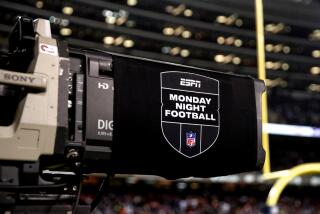Deal Gives Cable Giant First Whack at Films : Entertainment: Tele-Communications Inc. will invest up to $90 million in Carolco Pictures for right to show four movies on pay-per-view before they hit theaters.
In a move that could lead to vast changes in the movie-going experience, the nation’s largest cable TV operator on Friday secured the rights to broadcast four blockbuster films before they hit theaters.
Tele-Communications Inc., the Denver-based cable operator that serves about 20% of the nation’s 60 million cable households, said it would invest up to $90 million in Hollywood’s Carolco Pictures Inc. in exchange for permission to help develop and transmit four movies on pay-per-view cable TV over the next four years.
For TCI, the Carolco deal represents another step in its carefully crafted plan to increase its hold over the programming carried on its network, and an attempt to generate public interest and acceptance of its expanding lineup of pay-per-view entertainment.
For Carolco, which produced the hit, “Terminator 2: Judgment Day,” TCI’s infusion helps assure the studio’s financial stability, which was shaky until its partners and creditors agreed on a restructuring plan in December. Completion of the deal is dependent on regulatory approval of that restructuring, the two companies said Friday.
Debuting theatrical movies on pay-per-view television isn’t a new idea, although the TCI/Carolco venture is the most ambitious venture of its kind to date.
Universal Studios put “The Pirates of Penzance” on pay-per-view television in 1983 before the film played in theaters, but it attracted only a small audience. Executives at such industry giants as Time Warner and Fox Inc. have also considered having high-profile films debut on pay-per-view before they play in theaters.
Now, however, analysts say, similar deals are sure to follow.
“This obviously makes a tremendous amount of sense for cable operators and the studios,” said Thomas F. Gillett, a cable television consultant in St. Louis.
The odd men out in the deal appear to be theater and video store operators, who fear that the pay-per-view broadcasts will cut into their businesses.
“Most theater owners feel that playing a picture after it has been on pay-per-view television would be equivalent to committing economic suicide,” said William F. Kartozian, president of the National Assn. of Theater Owners, a trade group.
Analysts say the pay-per-view deal also poses a real threat to home video stores. If first-run pay-per-view becomes popular, they note, studios could reduce or even eliminate the 30-day to 45-day distribution advantage that video stores currently have before movies are released to cable TV.
Of the $90 million TCI can invest in the deal, $50 million will go toward purchase of an unspecified amount of the studio’s common stock. The balance represents a non-refundable fee for pre-theatrical, pay-per-view rights for four movies to be selected jointly by the two companies.
The deal provides that the pay-per-view revenues be split evenly between the two companies and allows TCI the right to air the movies up to three times on the weekend before their theatrical release.
Pay-per-view charges were not revealed, but advisers to TCI have said fees could be $30 per viewing. However, the fee might also include discounts for movie tie-in merchandise and theater tickets, the sources said.
Only one-third of the nation’s cable television homes are now equipped for pay-per-view, though the industry is quickly gearing up for expansion.
Some Hollywood executives Friday characterized the TCI/Carolco deal as experimental and said they see no threat to theatrically released films.
“It will never replace the experience of being in a dark theater with other people around you reacting to the movie on the screen,” said Sid Ganis, president of marketing and distribution for Columbia Pictures.
One concern has been that directors and stars might object to having theatrical quality films shown on television first.
“In the movie business, the first rule is keeping the creative community happy. Can you imagine that a director--after spending $40 million on what he thinks is a great movie for a 30-foot screen and brilliant sound system--will want to put that picture on a 20-inch screen with a three-inch speaker?” said one senior entertainment executive.
But sources familiar with the deal said that they don’t expect that to be a problem because the four films will be planned “from the ground up” as pay-per-view projects.
“Everyone will know from Day 1 that these are pictures intended to go to TCI,” said one source close to the deal, who also suggested that directors and stars might be eager to be involved in such an innovative project.
More to Read
The biggest entertainment stories
Get our big stories about Hollywood, film, television, music, arts, culture and more right in your inbox as soon as they publish.
You may occasionally receive promotional content from the Los Angeles Times.










